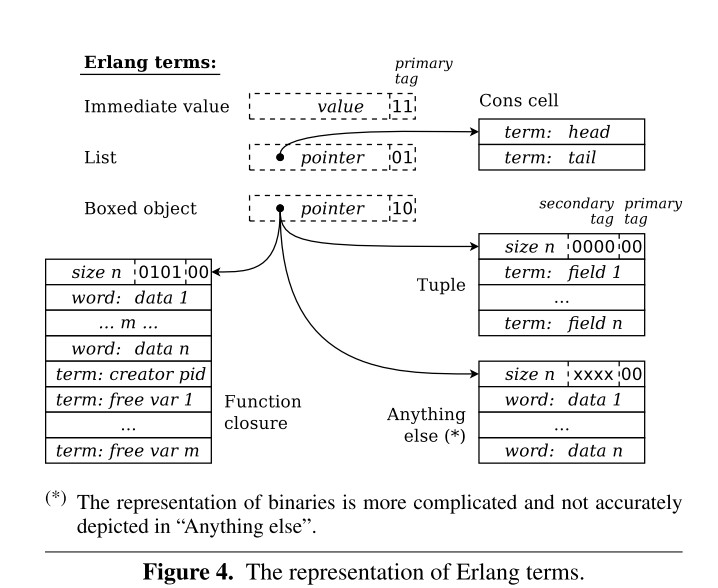
Erlang 增加 Maps数据类型并不是很突然,因为这个提议已经进行了2~3年之久,只不过Joe Armstrong老爷子最近一篇文章Big changes to Erlang掀起不小了风浪.这篇文章用了比较夸张的说法:"Records are dead - long live maps !",紧接着在国内国外社区这句话就传遍了.马上就有开发者忧心忡忡的在Stackoverflow上提问:Will Erlang R17 still have records?
套用一句文艺的话,当我们谈论Maps时,实际上是表达我们对record的不满,这些不满/痛点恰好就是我们寄希望于Maps能够提供给我们的.本文将尽可能的逐一列出这些点,并尝试分析原因,下篇文章将深入分析Maps的一些细节.
Record的痛点
使用Record我们遇到哪些痛点呢?这些痛点在Maps出现之后有所改善吗?我们先从细数痛点开始:
1.可以把record的name用作参数吗?
简单讲就是#RecordName{} 可以吗?
7> rd(person,{name,id}).
person
8> #person{}.
#person{name = undefined,id = undefined}
9> P=person.
person
10> #P{}.
* 1: syntax error before: P
10>
Is it possible to use record name as a parameter in Erlang
http://stackoverflow.com/questions/4103731/is-it-possible-to-use-record-name-as-a-parameter-in-erlang
http://stackoverflow.com/questions/4103731/is-it-possible-to-use-record-name-as-a-parameter-in-erlang
2.可以把record的filed作为参数使用吗?
10> N=name.
name
11> #person{N="zen"}.
* 1: field 'N' is not an atom or _ in record person
12>
Modify a record in Erlang by programmatically specifying the field to modify
解决这个问题可以关注dynarec项目,可以动态生成record字段值的getter和setter访问入口. https://github.com/jcomellas/mlapi/blob/master/src/dynarec.erl
3. a.b.c.d.e.f 能实现吗?
在有些语言中会有Fluent API(或 Fluent Interface)的设计,目的是在语法层面方便完成一系列连续的逻辑.在使用嵌套record的时候,我们特别希望能用a.b.c.d.e.f的方式来简化代码,而实际上是下面这个样子:
Eshell V6.0 (abort with ^G)
1> rd(foo,{a,b,c}).
foo
2> rd(a,{f,m}).
a
3> rd(f,{id,name}).
f
4> #foo{a=#a{f=#f{id=2002,name="zen"},m=1984},b=1234,c=2465}.
#foo{a = #a{f = #f{id = 2002,name = "zen"},m = 1984},
b = 1234,c = 2465}
5> D=v(4).
#foo{a = #a{f = #f{id = 2002,name = "zen"},m = 1984},
b = 1234,c = 2465}
6> D#foo.a#a.f#f.name.
"zen"
有一个开源项目recbird就可以实现这种效果,解决的路子当然是parse_transform, 需要在代码中添加-compile({parse_transform, recbird}).选项
recbird的作者是dcaoyuan,这个代码也是作为ErlyBird的一部分host在sourceforge:
4.record转proplists proplists转record
为什么要转换properlist?其目的就是方便检索字段值.
5.key只能是atom
的确有人提过这个
6.record往往要定义在hrl中
原因何在?
在record相关的问题中,常常提到的一个词就是"compile-time dependency",即record只存在于编译时,并没有对应实际的数据类型.record本质上是tuple在语法层面的语法糖,而上面record的诸多问题其实就是源于tuple,在著名的exprecs项目,有这样一段描述:
This parse transform can be used to reduce compile-time dependencies in large systems.
In the old days, before records, Erlang programmers often wrote access functions for tuple data. This was tedious and error-prone. The record syntax made this easier, but since records were implemented fully in the pre-processor, a nasty compile-time dependency was introduced.
This module automates the generation of access functions for records. While this method cannot fully replace the utility of pattern matching, it does allow a fair bit of functionality on records without the need for compile-time dependencies.
Record即Tuple
在内部表示没有record只有tuple, 下面是Erlang数据内部表示的介绍,我做了一个长图:
源文档地址:http://www.erlang-factory.com/upload/presentations/467/Halfword_EUC_2011.pdf (这个文档在我们的 Erlang Resources 小站多次推荐过)


这几张图可以帮助我们建立起来Erlang数据内部表示的思考模型,我们简单梳理一下:
Beam(Björns/Bogdans Erlang Abstract Machine)虚拟机,包含一个拥有1024个虚拟寄存器的虚拟寄存器机,程序变量可能存储在register或stack;垃圾回收是以进程为单位,逐代进行;Beam包含一个常量池( constant pool)不被GC.大型二进制数据在Heap外,并可被多个进程共享;VM Code中用来表达数据类型使用的概念是Eterm:一个Eterm通常一个字(word)大小( sizeof(void *)),进程的Heap实际上就是Eterm构成的数组,ETS也是以Eterm的形式存储数据.寄存器(register)也是Eterm,VM中的stack也是由Eterm组成;VM需要在进程heap上分配一些Eterm来表示一些复杂的数据结构比如list,tuple;如果变量指向的数据复杂,那么stack/register会包含指向heap的指针,换句话话说,Eterm要支持指针;
Eterm其实是使用一些二进制数据位来标记当前的数据类型,Erlang使用了一个层次化的标记系统,最基础的是使用最低两位primary tags来标识:
00 = Continuation pointer (return address on stack) or header word on heap
01 = Cons cell (list)
10 = Boxed (tuple, float, bignum, binary, external pid/port, exterrnal/internal ref ...)
11 = Immediate (the rest - secondary tag present)
01 = Cons cell (list)
10 = Boxed (tuple, float, bignum, binary, external pid/port, exterrnal/internal ref ...)
11 = Immediate (the rest - secondary tag present)
具体到Boxed类型,继续细分:
– 0000 = Tuple
– 0001 = Binary match state (internal type)
– 001x = Bignum (needs more than 28 bits)
– 0100 = Ref
– 0101 = Fun
– 0110 = Float
– 0111 = Export fun (make_fun/3)
– 1000 - 1010 = Binaries
– 1100 - 1110 = External entities (Pids, Ports and Refs)
– 0001 = Binary match state (internal type)
– 001x = Bignum (needs more than 28 bits)
– 0100 = Ref
– 0101 = Fun
– 0110 = Float
– 0111 = Export fun (make_fun/3)
– 1000 - 1010 = Binaries
– 1100 - 1110 = External entities (Pids, Ports and Refs)
看到了吧,这里已经没有record的踪影了,只有tuple,而对于Maps,我们已经可以在17.0-rc2/erts/emulator/beam/erl_term.h的代码中找到它的subtag:
#define ARITYVAL_SUBTAG (0x0 << _TAG_PRIMARY_SIZE) /* TUPLE */
#define BIN_MATCHSTATE_SUBTAG (0x1 << _TAG_PRIMARY_SIZE)
#define POS_BIG_SUBTAG (0x2 << _TAG_PRIMARY_SIZE) /* BIG: tags 2&3 */
#define NEG_BIG_SUBTAG (0x3 << _TAG_PRIMARY_SIZE) /* BIG: tags 2&3 */
#define _BIG_SIGN_BIT (0x1 << _TAG_PRIMARY_SIZE)
#define REF_SUBTAG (0x4 << _TAG_PRIMARY_SIZE) /* REF */
#define FUN_SUBTAG (0x5 << _TAG_PRIMARY_SIZE) /* FUN */
#define FLOAT_SUBTAG (0x6 << _TAG_PRIMARY_SIZE) /* FLOAT */
#define EXPORT_SUBTAG (0x7 << _TAG_PRIMARY_SIZE) /* FLOAT */
#define _BINARY_XXX_MASK (0x3 << _TAG_PRIMARY_SIZE)
#define REFC_BINARY_SUBTAG (0x8 << _TAG_PRIMARY_SIZE) /* BINARY */
#define HEAP_BINARY_SUBTAG (0x9 << _TAG_PRIMARY_SIZE) /* BINARY */
#define SUB_BINARY_SUBTAG (0xA << _TAG_PRIMARY_SIZE) /* BINARY */
#define MAP_SUBTAG (0xB << _TAG_PRIMARY_SIZE) /* MAP */
#define EXTERNAL_PID_SUBTAG (0xC << _TAG_PRIMARY_SIZE) /* EXTERNAL_PID */
#define EXTERNAL_PORT_SUBTAG (0xD << _TAG_PRIMARY_SIZE) /* EXTERNAL_PORT */
#define EXTERNAL_REF_SUBTAG (0xE << _TAG_PRIMARY_SIZE) /* EXTERNAL_REF */
#define BIN_MATCHSTATE_SUBTAG (0x1 << _TAG_PRIMARY_SIZE)
#define POS_BIG_SUBTAG (0x2 << _TAG_PRIMARY_SIZE) /* BIG: tags 2&3 */
#define NEG_BIG_SUBTAG (0x3 << _TAG_PRIMARY_SIZE) /* BIG: tags 2&3 */
#define _BIG_SIGN_BIT (0x1 << _TAG_PRIMARY_SIZE)
#define REF_SUBTAG (0x4 << _TAG_PRIMARY_SIZE) /* REF */
#define FUN_SUBTAG (0x5 << _TAG_PRIMARY_SIZE) /* FUN */
#define FLOAT_SUBTAG (0x6 << _TAG_PRIMARY_SIZE) /* FLOAT */
#define EXPORT_SUBTAG (0x7 << _TAG_PRIMARY_SIZE) /* FLOAT */
#define _BINARY_XXX_MASK (0x3 << _TAG_PRIMARY_SIZE)
#define REFC_BINARY_SUBTAG (0x8 << _TAG_PRIMARY_SIZE) /* BINARY */
#define HEAP_BINARY_SUBTAG (0x9 << _TAG_PRIMARY_SIZE) /* BINARY */
#define SUB_BINARY_SUBTAG (0xA << _TAG_PRIMARY_SIZE) /* BINARY */
#define MAP_SUBTAG (0xB << _TAG_PRIMARY_SIZE) /* MAP */
#define EXTERNAL_PID_SUBTAG (0xC << _TAG_PRIMARY_SIZE) /* EXTERNAL_PID */
#define EXTERNAL_PORT_SUBTAG (0xD << _TAG_PRIMARY_SIZE) /* EXTERNAL_PORT */
#define EXTERNAL_REF_SUBTAG (0xE << _TAG_PRIMARY_SIZE) /* EXTERNAL_REF */
感兴趣的话,可以继续在otp_src_17.0-rc2ertsemulatoreamerl_term.h中看到tuple实现相关的代码,搜索/* tuple access methods */代码段.
看到这里,Stackoverflow 有个问题讨论"Does erlang implement record copy-and-modify in any clever way?"
注意里面提到的erts_debug:size/1 和 erts_debug:flat_size/1方法,可以帮助我们查看共享和非共享状态数据占用的字数.所谓的共享和非共享,就是通过复用一些数据块(即指针指向)而不是通过数据拷贝,这样提高效率.在一些万不得已的情况下再触发拷贝,比如数据发往别的节点,存入ETS等等, Erlang Efficiency Guide 很多优化的小技巧都是从这个出发点考虑的.
那去掉primary tag和sub tag之后tuple是一个什么样的数据结构呢?我们可以从两个角度来看,首先是Erlang Interface Reference Manual中
erl_mk_tuple方法明确指示了tuple实际上是一个Eterm的数组:
ETERM *erl_mk_tuple(array, arrsize)
Types:
ETERM **array;
int arrsize;
Creates an Erlang tuple from an array of Erlang terms.
array is an array of Erlang terms.
arrsize is the number of elements in array.
Types:
ETERM **array;
int arrsize;
Creates an Erlang tuple from an array of Erlang terms.
array is an array of Erlang terms.
arrsize is the number of elements in array.
另外一个角度就是在bif.c中,tuple_to_list和list_to_tuple的实现,其实就是数组和链表的互相转换,看代码还可以知道通过make_arityval(len)冗余了数组的长度.对于tuple,获得size和按照索引访问数据都是很快的.这也就是找EEP43中提到过的Record的优势:
- 快速查询 O(1), 编译期间完成了对key的索引,对于小数据量存取相当快 (~50 values),
- 没有过多额外的内存消耗,只有Value和name 2+ N个字 (name + size+ N)
- 函数头完成匹配
而编译期一过,record提供的语法红利没有了,剩下的也就是快速获得tuple size和按照索引访问数据了.exprecs项目所谓 reduce compile-time dependencies 其实就是在编译阶段把一些语法红利继续保持下去,比如可以按照record name去new一个record,按照字段索引位置访问数据等等.上面提到的record与proplists的转换,实际上是把解决问题的时机从编译期推迟到了运行时.
说到这里,你可能非常期待了,Erlang R17之后加入的Maps又解决了什么问题?带来了什么惊喜呢?Maps与Record是一场你死我活的PK么?我们明天再说,敬请关注.
PS. Joe Armstrong老爷子文章中提到的Names in Funs 之前我们已经讨论过多次了:
[Erlang 0050]用fun在Erlang Shell中编写尾递归
http://www.cnblogs.com/me-sa/archive/2012/03/24/you-win-yourself-zen-this-is-the-50-erlang-article-go-on.html
http://www.cnblogs.com/me-sa/archive/2012/03/24/you-win-yourself-zen-this-is-the-50-erlang-article-go-on.html
[Erlang 0063] Joe Armstrong 《A Few Improvements to Erlang》EUC 2012
http://www.cnblogs.com/me-sa/archive/2012/06/06/2538941.html
相关资料:
[0] setelement/3 优化http://www.erlang.org/doc/efficiency_guide/commoncaveats.html#id62422